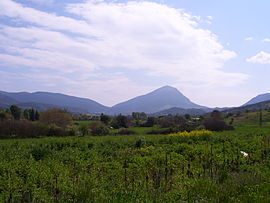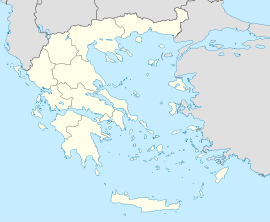- Troezen
-
Troezen
Τροιζήνα
Ortholithi MountainLocation Coordinates 37°28′N 23°25′E / 37.467°N 23.417°ECoordinates: 37°28′N 23°25′E / 37.467°N 23.417°E Government Country: Greece Region: Attica Regional unit: Islands Municipality: Troizinia Districts: 8 Population statistics (as of 2001) Village - Population: 671 Municipal unit - Population: 6,507 - Area: 190.697 km2 (74 sq mi) - Density: 34 /km2 (88 /sq mi) Other Time zone: EET/EEST (UTC+2/3) Elevation (center): 23 m (75 ft) Postal: 180 20 Telephone: 22980 Website www.dimos-trizinas.gr Troezen (
 /ˈtriːzən/; Greek: Τροιζήν, modern: Τροιζήνα Troizina) is a small town and a former municipality in the northeastern Peloponnese, Greece. Since the 2011 local government reform it is part of the municipality Troizinia, of which it is a municipal unit.[1]
/ˈtriːzən/; Greek: Τροιζήν, modern: Τροιζήνα Troizina) is a small town and a former municipality in the northeastern Peloponnese, Greece. Since the 2011 local government reform it is part of the municipality Troizinia, of which it is a municipal unit.[1]Troezen is located southwest of Athens, across the Saronic Gulf, and a few miles south of Methana. The seat of the former municipality (pop. 6,507) was in Galatas. Troizina was part of Piraeus Prefecture (in antiquity it was part of Argolis). The municipality had a land area of 190.697 km². Its largest towns and villages are Galatás (pop. 2,592 in 2001), Kalloní (pop. 751), Troizína (pop. 671), Taktikoúpoli (391), Karatzás (350), Dryópi (318), Ágios Geórgios (284), and Agía Eléni (227). There are numerous smaller settlements.
Troezen in mythology
According to Greek mythology, Troezen came into being as a result of two ancient cities, Hyperea and Anthea, being unified by Pittheus, who named the new city in honor of his deceased brother Troezen.[2]
Troezen was the place where Aethra, daughter of Pittheus, slept with both Aegeus and Poseidon the same night, and fell pregnant with the great Greek hero Theseus. Before returning to Athens, Aegeus left his sandals and sword under a large boulder in Troezen, and requested that when the child was able to prove himself by moving the boulder he must return the items to his father in Athens; Theseus did indeed lift the boulder when he came of age.[3]
Troezen is also the setting of the Euripides tragedy Hippolytus, which recounts the story of the eponymous son of Theseus who becomes the subject of the love of his stepmother, Phaedra. While fleeing the city, Hippolytus is killed when his chariot is attacked by a bull rising from the sea. Other plays on the same subject have been written by Seneca and Jean Racine, also set in Troezen.
The ancient city also possessed a spring, supposedly formed where the winged horse Pegasus once came to ground.
Troezen in history
A cult built up in the ancient city around the legend of Hippolytus. Troezen girls traditionally dedicated a lock of their hair to him before marriage.
Before the Battle of Salamis (480 BC), Athenian women and children were sent to Troezen for safety on the instructions of the Athenian statesman Themistocles. In 1959 a stele was found in a coffee house in Troezen, depicting the Decree of Themistocles, the order to evacuate Athens. The stele has since been dated to some 200 years after the Battle of Salamis, indicating that it is probably a commemorative copy of the original order.
The temple of Isis was built by the Halicarnassians in Troezen, because this was their mother-city, but the image of Isis was dedicated by the people of Troezen.
References
- ^ Kallikratis law Greece Ministry of Interior (Greek)
- ^ Pausanias, Description of Greece, 2. 30. 9
- ^ Apollodorus, Bibliotheca, 3. 15. 7
Municipal unit of Methana Municipal unit of Troizina Categories:- Populated places in Islands (peripheral unit)
- Ancient Greek cities
- Troizina
- Battle of Salamis
- Geography of ancient Argolis
Wikimedia Foundation. 2010.



